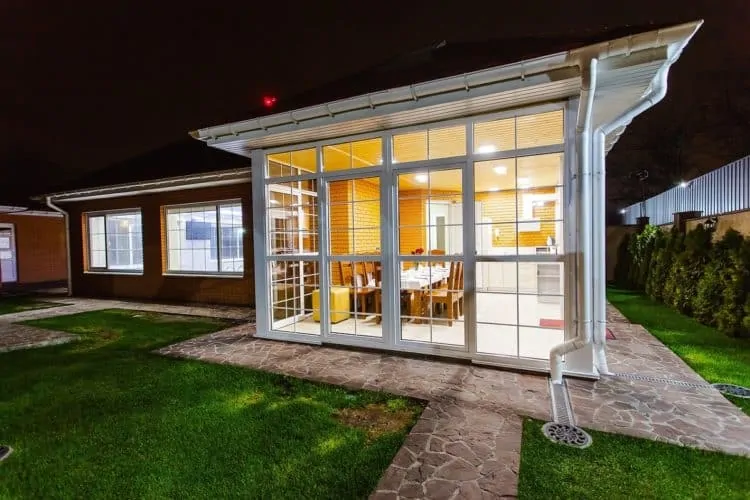
- By Remodel Works
- In Blog
What is a Granny Flat
You aren’t alone if you’re asking yourself the question, “What is a granny flat?” With the demand for housing growing around the United States – and especially in California – more people are talking about adding a granny flat to their home as a way to expand their living space and make room for extended family or renters. This type of secondary dwelling gets its name because it is a popular way for families to house and care for aging family members like grandparents. However, anyone can live in this type of dwelling.
There is a lot to learn and consider before you add a granny flat to your home. It’s important to know what this type of dwelling can offer and how it can work for you. It’s even more critical that you understand cost factors and permitting issues when you are considering building a granny flat.
To help you decide if adding a granny flat to your home is right for you, we are discussing what a granny flat is and the amenities one can include as well as the advantages and disadvantages of this type of dwelling for homeowners. We’re also reviewing California granny flat law to help you understand permitting and how a company like Remodel Works can help you avoid the dangers of working with an unqualified general contractor on this type of home improvement project.
What Is A Granny Flat?
A granny flat is a self-contained living area located on the property of a single-family home. It is designed for one or two people. Although some granny flats can be 1,200 square feet, many of these structures can be classified as tiny houses due to their size. Such a flat can be attached to the home, which is perfect for smaller properties and homeowners who want easy access between the home and the granny flat. This type of building can also be detached from the primary dwelling for more privacy.
The amenities in a granny flat vary depending on the preferences of the homeowner and the size. For example, some granny flats are simply smaller versions of a full-sized home. Others may have a more-simple setup that includes a mini-fridge and a microwave on a countertop instead of a full kitchen. Regardless of the amenities, most granny flats are smaller than the typical home, so family members who move into them will need to downsize.
The building industry often calls a granny flat an accessory apartment or an accessory dwelling unit (ADU). People outside of the industry might refer to this type of home as a mother-in-law unit, an in-law apartment, a carriage unit, or a granny pod, or any other popular name.
As more families are embracing multigenerational housing and the Baby Boomers are continuing to age, granny flats in San Diego and around the country are becoming more prevalent. In fact, many realtors and builders have said that having one of these accessory dwelling units is an excellent selling point for a home.
Although some homeowners use granny flats as rental units to earn additional income, not every city allows this. As a result, it is important to check the zoning laws in California and review any deed restrictions to make sure that there is nothing that bans renting a granny flat.
Advantages and Disadvantages of a Granny Flat
As with all things in life, granny flats have their advantages and disadvantages. Deciding if one is a good fit for you and your home will involve weighing these pros and cons. To help make your decision a little easier, we’ve compiled some of the most common advantages and disadvantages of adding one of these dwellings to your property.
Advantages of Adding a Granny Flat
One of the advantages of adding a granny flat is the resale value that the additional space adds to your home. Again, with an aging population and an interest in intergenerational living situations, granny flats are growing in popularity among home buyers. Having such a dwelling can make your home more desirable and valuable.
Families who build a granny flat to house aging family members often find there are many benefits for everyone in the family. Research shows that seniors have better mental and physical health when they have social contacts, which living in a granny flat near a younger family can provide. Living in close proximity to aging family members also allows homeowners to monitor their health and wellness. Another benefit of a granny flat for grandparents is that they are able to spend more time with their grandchildren.
Having another person living on the property, regardless of whether or not they are family, can provide some other advantages. For example, having another tenant on the property can provide more security, especially if the granny flat is facing the side or back of the lot. Additionally, tenants may share amenities and chores with each other. This may mean that tenants can split childcare and home maintenance tasks. If your city allows you to rent a granny flat, the additional income is another bonus of adding this type of building to your property.
Disadvantages of Adding a Granny Flat
Although adding a granny flat to a property comes with many wonderful benefits, it also has some disadvantages. One of the biggest issues for homeowners is the cost of constructing such a dwelling. New construction comes with certain costs. From the costs that come to mind first like supplies and labor, to the ones that are less obvious like connecting utilities and permits, it can be an expensive endeavor in some situations.
Another disadvantage of constructing a granny flat are the regulatory and legal barriers. Before you begin building, you need to consider the local laws, zoning regulations, building restrictions, and deed restrictions. These rules and regulations may limit or prevent you from building a granny flat on your property. However, California recently made it easier to build granny flats.
Some homeowners may decide to ignore or work around any regulations by converting a garage or some other structure on the property, without getting approval first. We do not recommend trying to ignore or circumvent the law because it turn out to be a costly mistake.
A Look at California Granny Flat Law
It’s no secret that California is experiencing a major housing shortage. Over the past ten years, the state has seen 80,000 homes built each year. However, that’s 100,000 homes less than what is needed to keep up with the projected population growth through 2025.
This is one of the reasons why the cost of living in California is so high. In fact, the median home value in California in 2017 was about $490,000, which is more than twice the national average. As a result, homeownership in California is at a 70-year low.
With more Californians moving in together to share a room or a home, more people have been choosing to add an accessory unit such as a granny flat to their main residence. While some of these people are families looking to save money by living on the same property, others are people who are renting properties. Luckily, California law has recently changed to accommodate more of these types of dwellings and support more affordable housing.
In September 2016, California revoked all city-level ordinances for granny flats. This included everything from parking restrictions, to requirements for fire sprinklers. In its place, lawmakers established a much more lenient criteria for approving a granny flat. This has made it easier and less expensive to build granny flats throughout the state of California.
Under California granny flat law, water and sewer agencies cannot charge hookup fees for structures built within an existing structure or an existing detached unit on the same lot. The granny flat also does not need its own electrical hookup from a utility provider. These changes in the law remove some of the financial obstacles of adding a granny flat.
The law also states that local agencies are not permitted to impose parking rules for certain granny flats. These include those within a half-mile of public transit or that are part of the existing primary residence. This means that city officials cannot tell a homeowner in these situations that they cannot add a granny flat to their property due to lack of street parking.
To help expedite the process of building a granny flat, California law states that cities must approve granny flat applications within 90 days. Additionally, a city can only deny an application for a granny flat if the project will not comply with the law.
Granny Flat Building Tips
Many homeowners are a bit overwhelmed when they make the decision to build a granny flat on their property. However, with the right team of granny flat builders and proper guidance, the process can be seamless and stress-free.
It’s not uncommon for homeowners to think they’re saving money by hiring a general contractor who provides a low estimate or trying to build a granny flat themselves. The people who try to build on their own often find themselves overwhelmed and over-budget on their building project. As for those who partner with a general contractor who promises to build it for less, they often find the arrangement to be lacking. For your project, you want a company that understands granny flat construction projects and knows how to build a high-quality structure.
Before selecting a granny flat builder, you should ask a few important questions.
- Ask the company if they are licensed and request to see their license number. Working with a licensed company is important for projects – both big and small.
- Request a list of references and completed projects. If you ask, you may even be able to walk through a completed granny flat project to assess the quality.
- Review the company’s website to make sure it is professional and helpful. A professional website suggests that a company will be professional in other ways.
- Receive a quote and find out what is included. Some companies may only quote the price for basics and leave out certain services to make their quote look cheaper than the competitors. Make sure you know what the final price will be for your project.
Design Tips for Inside and Outside
The finishing touches on the granny flat are also very important. On the outside, you may want to create a seamless connection between the main house and the granny flat. You can accomplish this by using similar building materials and adding a path between the two dwellings. You can also add garden areas surrounding the path to enhance the beauty of the outdoor space.
As for the inside, some simple touches and design elements can make the space feel like a home. An L-shaped kitchen can help you make the most of a small space by storing everything you need in one convenient space that is open to the living room. Also consider adding windows on all sides of the floorplan to help fill the space with beautiful natural lighting.
Why Remodel Works?
As a San Diego-based building company, Remodel Works has the experience to make every home project a success. When our team starts any project, we create a meticulous plan that includes all aspects involved in building out your space. From flooring to roofing, we make sure that everything is included, from the initial idea through construction.
For the last three decades, we’ve been helping homeowners remodel and expand their living spaces. When it comes to building home extensions and granny flats, our knowledgeable and diligent contractors handle every step and keep you informed throughout the process. We know that your time and money are precious, so we never waste them.
Because we are based in California, we understand the state’s granny flat laws and regulations. This allows us to make sure that every project stays in compliance, so you don’t experience any legal or regulatory problems later. We also have experience building high-quality dwellings that are built to last.
Using the information in this article and the experience of the Remodel Works team, you can take advantage of the many benefits of adding a granny flat to your property.
For more information about granny flats, check out our articles on the zoning laws in California and granny flat regulations in San Diego.











